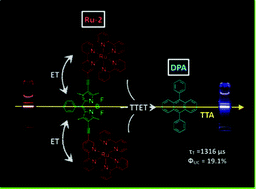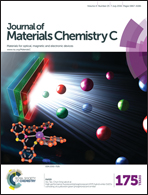Dual phosphorescent dinuclear transition metal complexes, and their application as triplet photosensitizers for TTA upconversion and photodynamic therapy†
Abstract
Two novel homo Ru(II) and Ir(III) complexes (Ru-2 and Ir-2), containing a bridging boron-dipyrromethene (BODIPY) chromophore were synthesised. The BODIPY moiety was covalently attached to the coordinated bipyridine (bpy) or phenylpyridine (ppy) via two acetylene linkers to produce bimetallic-complexes, which were employed as triplet photosensitizers. Both Ru-2 and Ir-2 absorb strongly in the visible region (λabs = 570 nm, ε = 113 317 dm−3 mol−1 cm−1 for Ru-2 and λabs = 567 nm, ε = 105 713 dm−3 mol−1 cm−1 for Ir-2). Due to a strong intraligand feature, and a small contribution from the metal, to the triplet state, the triplet-state lifetimes are particularly long for both complexes (1316.0 μs for Ru-2, 630.7 μs for Ir-2). High upconversion quantum yields were found (19.1% for Ru-2 and 25.5% for Ir-2). The intermolecular triplet energy transfer between the metal centres were studied using nanosecond time-resolved transient absorption spectroscopy (ΦTTET = 94% Ru-2 and ΦTTET = 86% Ir-2). Knowing the desirable photophysical properties of the complexes, both were then tested for their application in photodynamic therapy (PDT).

- This article is part of the themed collection: 2016 Journal of Materials Chemistry C Hot Papers

 Please wait while we load your content...
Please wait while we load your content...